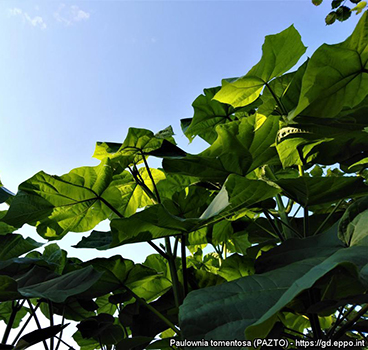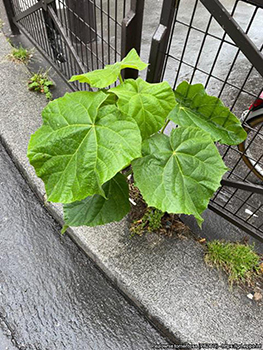
EPPO Alert List – Paulownia tomentosa (Paulowniaceae)
Why
The EPPO Panel on Invasive Alien Plants suggested that Paulownia tomentosa (Paulowniaceae) could be included on the EPPO Alert List with the aim of gathering additional information on the occurrence of the species in the EPPO region. Additionally, the Panel is seeking information on its impacts, both economic and ecological from across its non-native range.
Geographical distribution
EPPO region: Austria, Belgium, Czech Republic, France (including Corsica), Germany, Hungary, Italy (including Sardinia and Sicily), Slovenia, Switzerland, United Kingdom.
Africa: South Africa.
Asia: China (native) (Anhui, Gansu, Hebei, Henan, Hubei, Hunan, Jiangsu, Jiangxi, Liaoning, Shaanxi, Shanxi, Sichuan), Korean peninsula (native), Japan.
North America: Alabama, Arkansas, Connecticut, Delaware, Florida, Georgia, Hawaii, Louisiana, Maryland, Mississippi, New Jersey, New York, North Carolina, Ohio, Oklahoma, Pennsylvania, South Carolina, Tennessee, Texas, Virginia, Washington, West Virginia.
Oceania: New Zealand.

Planted trees along the pavements in Paris (FR)
Courtesy: Rob Tanner (EPPO)

Leaves of Paulownia tomentosa
Courtesy: Matteo Maspero

Growing from seed in Paris (FR)
Courtesy: Rob Tanner (EPPO)
Morphology
Tree up to 20 m tall; crown broad, umbelliform.
Bark: brown-grey. Twigs conspicuously lenticellate, viscid glandular when young.
Leaf blade cordate, approximately 40 cm, abaxially densely to sparsely hairy, adaxially sparsely hairy, apex acute.
Inflorescence: thyrses pyramidal to narrowly conical, up to 50 cm long; cymes 3- or 4-flowered; peduncle 1-2 cm, nearly as long as pedicels.
Flowers: calyx shallowly campanulate, ca. 1.5 cm, outside tomentose; lobes up to 1/2 or more calyx length, ovate-oblong. Corolla purple, funnelform-campanulate, 5-7.5 cm, ridged ventrally, outside glandular, inside glabrous; limb ca. 4.5 cm in diam. Stamens up to 2.5 cm. Ovary ovoid, glandular. Style shorter than stamens. Flowering April-May.
Capsule: ovoid, 3-4.5 cm, densely viscid-glandular hairy; pericarp ca. 1 mm; persistent calyx lobes flat.
Seeds: 2.5-4 mm including wing.
Biology and Ecology
Paulownia tomentosa is a deciduous fast growing tree species which produces thousands of seed capsules containing up to 2 000 small light winged seeds each, which can be easily transported by wind and water over large distances. Seeds can survive in the seed bank for 2 – 3 years. P. tomentosa can also reproduce from root sprouts.
Habitats
Paulownia tomentosa is a pioneer species and can colonize disturbed urban habitats in the EPPO region. It is recorded growing in crevices between paving stones, xerophytic ruderal vegetation, wall crevices and railway habitats. P. tomentosa prefers areas with good light and mineral soils with adequate moisture for germination and establishment. In North America, the species has been shown to invade more natural habitats for example forests and forest margins where there is some level of disturbance.
Pathways for movement
Paulownia tomentosa is a commonly planted tree species in cities and urban parks due to its floristic elegance. Due to the fast growth rate of P. tomentosa, and other Paulownia species and possible hybrids, this group is being assessed for utilisation for timber or biomass production in plantations and agroforestry systems, which could become more important in the future.
Impacts
Information on ecological and economic impact are sparse. Management of the species in urban areas (e.g. railway embankments) can incur economic costs. In North America, the species is considered to be moderately invasive and can have negative impacts on native plants communities in the eastern United States.
Control
Physical and or mechanical control can be effective at controlling P. tomentosa. Mature trees can be cut at ground level before the onset of flowering. Because P. tomentosa spreads by suckering, root sprouts are common after treatment, and additional control methods, such as repeated cutting for sprouts or herbicidal control to prevent sprouting, may be required.
Sources
Badalamenti E (2019) Notes about the naturalization in Sicily of Paulownia tomentosa (Paulowniaceae) and remarks about its global spread. Flora Mediterranea 29, 67-70.
Essl F (2007) From ornamental to detrimental? The incipient invasion of Central Europe by Paulownia tomentosa. Preslia -Praha- 79.
Longbrake ACW (2001) Ecology and invasive potential of Paulownia tomentosa (Scrophulariaceae) in hardwood forest landscape. Ohio University, 174 p. PhD. Dissertation.
Lovenshimer JB, Madritch MD, (2017) Plant community effects and genetic diversity of post-fire princess tree (Paulownia tomentosa) invasions. Invasive Plant Science and Management 10, 125–135.
Snow WA (2016) Ornamental, crop, or invasive? The history of the empress tree (Paulownia) in the USA. Forests, Trees and Livelihoods 24, 85-96.
Webster CR, Jenkins MA, Jose S (2006) Woody invaders and the challenges they pose to forest ecosystems in the Eastern United States. Journal of Forestry 104, 366–374.
